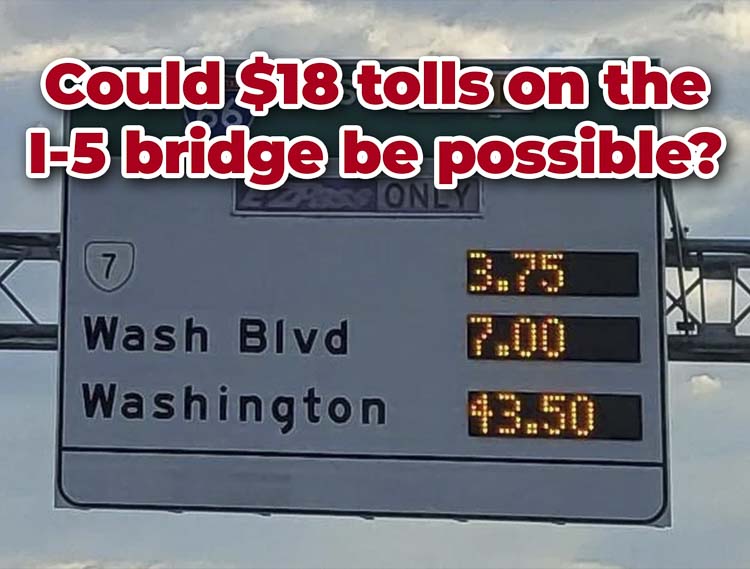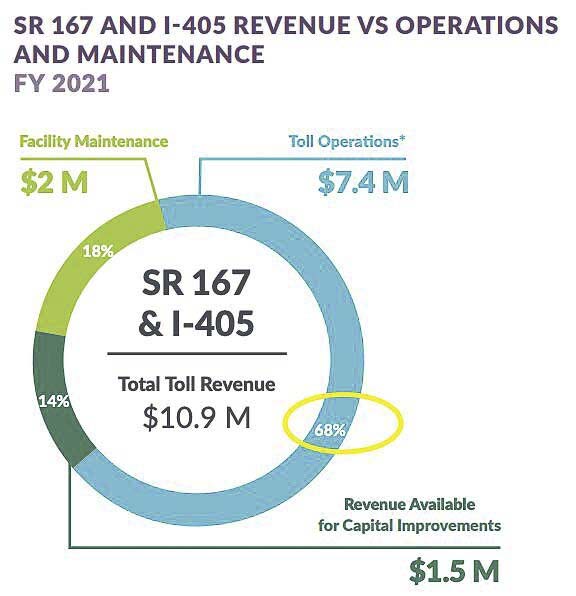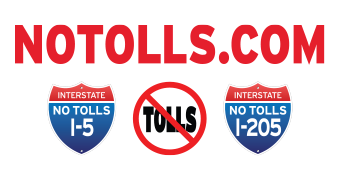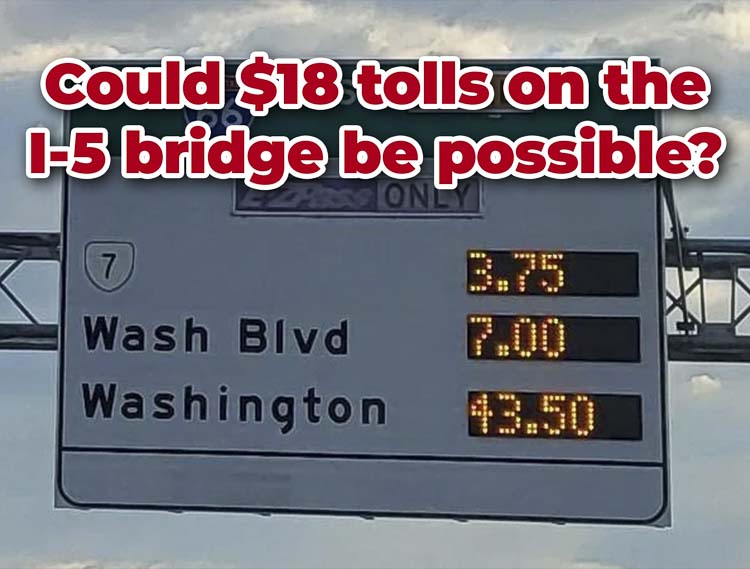Drivers could be paying 16 times more each year to cross the Columbia River on I-5
Thursday, October 24, 2024 — Clark County Today
John Ley
For Clark County Today
The average Washington state citizen pays $146.40 a year in Washington state gas taxes according to one report. Under the possible tolling scenarios under discussion by the Interstate Bridge Replacement Program (IBR), drivers could be paying 16 times more each year to cross the Columbia River on I-5. At $9.40 per day for a round trip, tolling costs would be $2,350 a year. Freight haulers could pay up to four times more.
Even at the low end, $3.10 per day equals $775 per year. That’s five times what people are paying in gas taxes to drive at no additional cost all over the two states.
Washington and Oregon are moving forward to toll the I-5 Bridge. Those plans include “pre completion” tolling. Administrator Greg Johnson and the IBR team recently increased the amount they want to borrow from Wall Street by $100 million, paid for by tolling collections. They are now seeking $1.2 billion to $1.6 billion to pay for the escalating price of their proposed project.
Many citizens are rightly concerned IBR tolls are simply the camel’s nose getting into the tent. Once they are allowed, it would potentially expand on both sides of the Columbia River. Unelected members of the Washington and Oregon Transportation Commissions will set toll rates for the bridge.

This is extremely important for Portland metro area citizens as the Washington state legislation, which authorized tolling on the Interstate Bridge replacement project, indicated the maximum tolls cannot exceed the maximum tolls collected in the state. That means the $4.70 maximum I-5 Bridge tolls presently under consideration could jump to at least $15 and perhaps $18 each way in the future. The $18 maximum toll would be $9,000 per year for two daily crossings, 50 weeks a year.
That’s because the Washington state legislation authorizing tolling allows the IBR tolls to be whatever is the “highest in the state.” The Washington State Transportation Commission (WSTC) is now considering increasing maximum tolls for the second time in just over a year. They initially considered that amount a year ago.
One major reason tolls charge so much is the cost of collection is extremely high. In Washington state, collection costs have run from 19 percent of funds collected to as high as 68 percent. In Oregon, the recently “paused” I-205 tolling effort had an 83-86 percent cost of collection. The gas tax has just a 1 percent cost of collection.
Polling indicated that between 70 and 90 percent of Portland area voters object to tolling as a means of raising transportation dollars. The high cost of collecting tolls leaves little money to actually pay for the proposed construction. The public outcry caused Oregon Gov. Tina Kotek to “pause” Oregon’s tolling, demanding the legislature consider multiple new ways to fund the roughly $3 billion shortfall on current ODOT projects.
In 2023, the Washington State Department of Transportation (WSDOT) Tolling Division’s annual report indicated the state spent $54.8 million on Vendor and Non-Vendor Expenditures. They collected $195.9 million in total revenue. Systemwide, the five tolling facilities had a combined 28 percent cost of collection.
Had WSDOT collected the $195.9 million via the gas tax, the collection cost would have been about $1.9 million. This would have left an additional $52 million for maintaining roads and bridges. That is a significant savings on administrative costs.
Toll rate history
At the beginning of this year, the WSTC increased tolls significantly on I-405, SR-167, and SR-520. Maximum tolls on the I-405 HOT (High Occupancy Toll) lanes increased 50 percent from $10 to $15. On SR-167 they increased from $9 to $15. An increase on the SR-520 Lake Washington bridge averaged 10 percent.
Less than a year later, the WSTC is considering another toll rate increase. Raising the maximum tolls to $18 is in play, reports KIRO news. So is expanding the three-plus HOV requirement for free trips on SR 167. As is tolling I-405 on the weekends. Right now, those lanes are free.
WSTC’s Deputy Director Carl See said the agency is trying to thread the needle on price and capacity for I-405/SR-167 tolls. The goal of the congestion pricing toll model is to price people out of the toll lanes to ensure a faster trip for vehicles in them, according to the WSTC. Changing who can drive in the lanes for free might get a few more cars out of them as well.

“We are weighing the trade-offs there between the $15 and $18,” he said. “We recognize that $18, the higher you go, the more difficult it is for people to afford to use those lanes and the kind of choices people have to make.”
Tacoma Narrows Bridge tolls
Paying off a transportation credit card with tolling is expensive. Washington state’s experience with the Tacoma Narrows Bridge is on track to spend nearly three times the amount originally borrowed. Tolling revenues have fluctuated significantly and political pressures triggered legislature intervention multiple times.
After 16 years of paying tolls, the WSTC reports about $586 million remains to be paid off. This is just $98 million less than the original loan.
The Narrows Bridge is in reality two separate bridges, like the I-5 Bridge. The second bridge was constructed in 2007, doubling vehicle capacity to address growing traffic demand. It is 5,979 feet long, provides 187.5 feet of clearance below for marine traffic and has eight total lanes. Tolls are only collected in the southbound direction.
The bridge was built for $786 million of which $684.2 million was borrowed from Wall Street. The loans were supposed to be paid back by tolling revenues. Yet over the past decade, the Washington State Legislature has provided over a hundred million in subsidies and loans to keep the tolling program for the Narrows Bridge afloat Most recently was $130 million in 2022, which in part lowered toll rates by 75 cents in October 2022.
From a financial perspective, after paying tolls for roughly 17 years, the “credit card” balance has been reduced by only about $100 million on the Narrows Bridge. Collection costs and interest on the loan have consumed far too much of the money drivers are paying at the toll booth.
Members of the Oregon legislature have recently completed a tour around the state seeking input on how to raise money to fill the hole at ODOT. This includes tolling and/or a Road User Charge (RUC). But the first $3 billion would deliver nothing new. It would simply allow them to finish what was promised in the $5.3 billion HB2017 package, turning it into an $8.3 billion transportation package.

Citizens should weigh how much extra would be taken from their pockets, if tolling is one of those funding choices. Oregon voters can sign IP-31 to guarantee a “Vote Before Tolls”.
The gas tax has several advantages for taxpayers. First, the rate is raised by elected government officials, rather than unelected individuals appointed by each state’s governors. It’s much easier to pressure politicians who are concerned about reelection. But from a financial perspective, the 1 percent cost of collection of the gas tax is much more efficient than tolling with a 20 percent to 70 percent cost of collection.
On the I-5 Bridge replacement project, citizens can make input to the Draft Supplemental Environmental Impact Statement. You have until Nov. 18 to comment. Click here and scroll down to enter your comments and concerns. You can address any aspect of the program, including tolling and the funding.



2 comments
Anjelaka Andrews
November 14, 2024 at 8:22 pm
Adding tolls on top of all the taxes we already pay will severely, negatively impact the economy and the workers who keep this country afloat. The crisis is already out of hand with inflation prices making it harder and harder for average families to maintain a feasible and affordable life, for them and thier loved ones.
Raising such things as this will put households in even more disarray than they already are. Leading to further mental health crisis, financial ruin and adding to the drug and alcohol problems a lot of Americans. Most already use escapism with such substances due to the lack of mental health affordability and financial house crisis that’s already upon us.
We as a community need to look at the bigger picture.
Dan McDonald
November 27, 2024 at 6:11 am
All this has been covered on the NoTolls update page: “[Users] are facing multiple possible tolls on area freeways. They will be asked to pay to drive on roads taxpayers have already paid for. ODOT’s Don Hamilton wants to modify your behavior, encouraging people to take mass transit or drive during times the roads are less congested.” Ask Portlanders if expensive light rail and other ‘green’ boondoggles have resulted in fewer cars on the road. I think the answer is obvious.